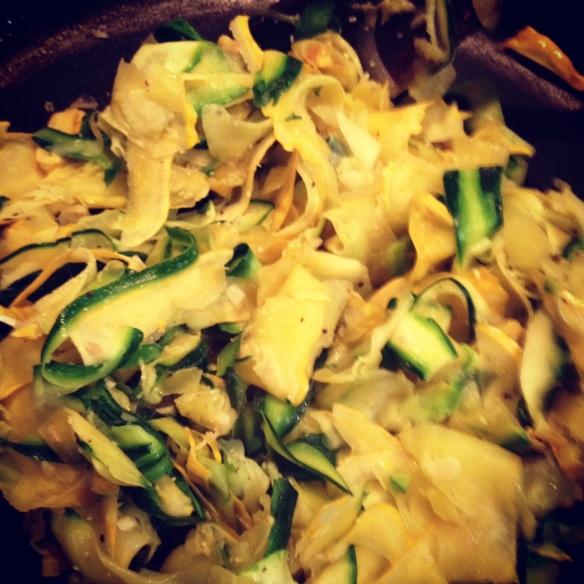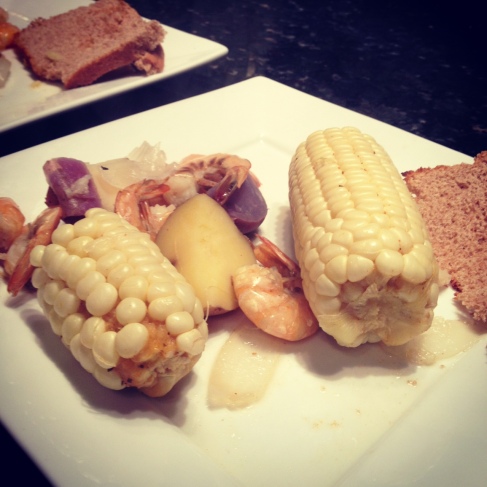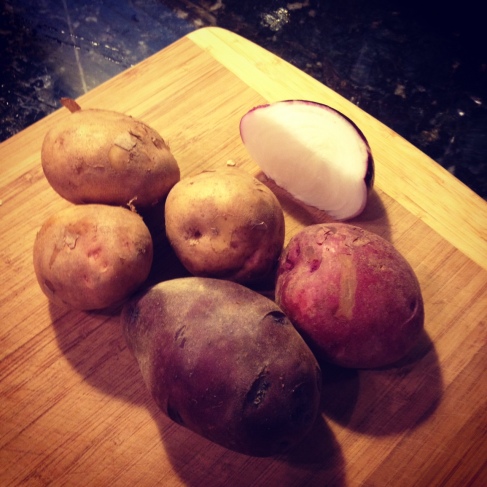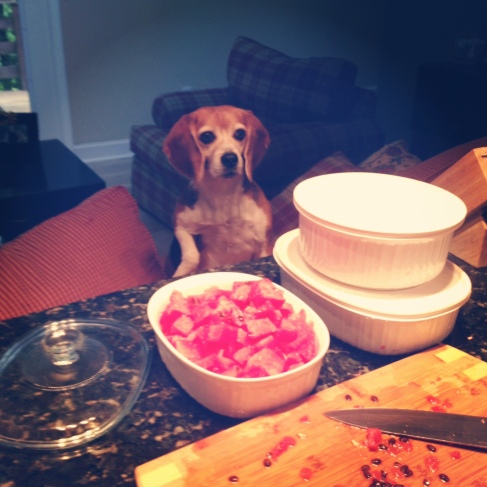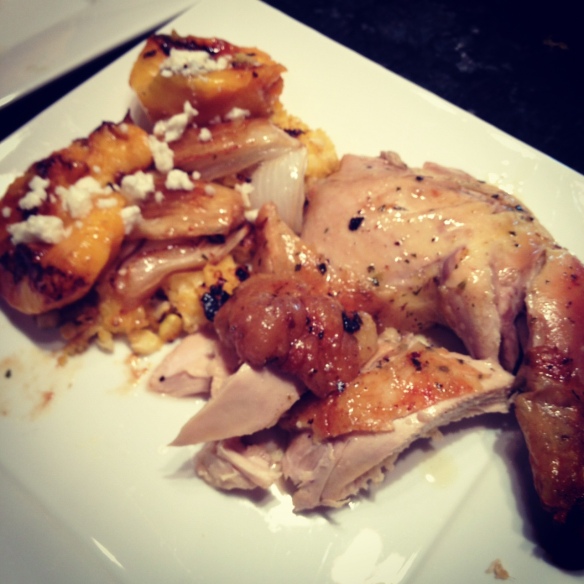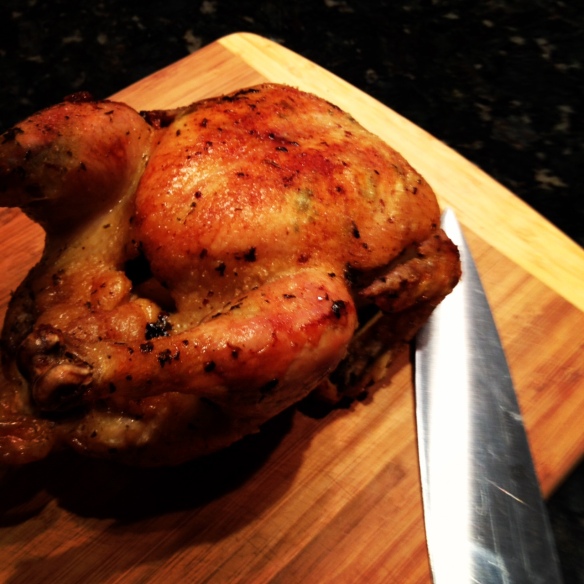I’ve been MIA because, honestly, I haven’t really cooked anything the past few days that hasn’t already appeared here. So, I’m going to change directions for today because some have asked how I fuel for distance training (and I’m totally kidding–no one’s asked that, but I wanted to write about it, so there you go).
 Fueling for endurance sports can be intimidating if you bother to read any number of articles. Since I don’t have a degree in nutrition and can’t even begin to figure out the ratio of carbs to protein to fat to…everything that’s going to sustain me during my training, I’m just going to write about my everyday nutrition. (Yeah, nutrition. I’m not on a diet. Seriously, I will slap the next person who says, “Oh Mindy? She’s on a diet.” No, I’m not. I’m not sure how you even diet when you’re doing endurance sports. I just eat right. That’s it. End of discussion.) Again, this is what works for me during a typical weekday. I’m not an elite athlete. I have a desk job. This is just what I know won’t make me heave in the middle of a tempo track workout. What’s going to be okay on my stomach if I’m slugging out 7 miles in 90-degree weather.
Fueling for endurance sports can be intimidating if you bother to read any number of articles. Since I don’t have a degree in nutrition and can’t even begin to figure out the ratio of carbs to protein to fat to…everything that’s going to sustain me during my training, I’m just going to write about my everyday nutrition. (Yeah, nutrition. I’m not on a diet. Seriously, I will slap the next person who says, “Oh Mindy? She’s on a diet.” No, I’m not. I’m not sure how you even diet when you’re doing endurance sports. I just eat right. That’s it. End of discussion.) Again, this is what works for me during a typical weekday. I’m not an elite athlete. I have a desk job. This is just what I know won’t make me heave in the middle of a tempo track workout. What’s going to be okay on my stomach if I’m slugging out 7 miles in 90-degree weather.
You’ll see below that I’m basically a 33-year-old baby with feeding times. I am constantly eating. Anyone who walks by my office? Guarantee that you’ll find me eating and/or chugging water. But, aside from a daily bagel, nothing in here is processed or refined.
5:35 a.m. (or earlier depending on what time our cat sticks her paw in my nose, on my face, or in my ear, her way of saying, “OhmygodI’mgoingtodieifyoudon’tfeedmenowit’sbeenlike11hourssinceyou’vefedmeFEEDME,” which then triggers the beagles to go all schizo and start running around the bed because “Ohmygodwe’veNEVERbeenfedFEEDMEPETMEFEEDME”): Up to, obviously, feed the pets. If I have a shorter run of 30-35 minutes, I may get up even earlier to do that run, especially during the summer.
7:45 a.m.: After checking email, etc. at work, fill up my water bottle so I can start getting my first few cups of the day. I try to have two bottles finished off by the time I leave for lunch. (No, I do not drink coffee. I’m not sure how anyone does. Neither do I drink any sodas or energy drinks, ever.) Start on my first “breakfast” of the day, which is now a fruit smoothie (recipe below, you’re welcome, it’s fantastic).
8:30 a.m.: Eat first serving of whole fruit (depends on what’s in season at the market, but usually an apple is in here somewhere).
9:30 or 10 a.m.: Second serving of whole fruit.
12:45 p.m.: Lunch at home, which is usually a salad with veggies and 2-3 oz. of protein (usually fish for shorter runs and chicken for longer runs). More water.
1:30 or 2 p.m.: Another serving of whole fruit.
2:15 p.m.: A tablespoon of crack. Not the illegal kind. The peanut butter kind. Athletes in this area know this stuff. It’s gold in a jar. It’s made by the 91- or 92-year-old mom of a local farmers market vendor. We go through a jar of this stuff each week, maybe more because sometimes you find the jar of PB in one hand, a spoon in the other, and you just let nature take its course. Ten minutes later, you realize you’ve eaten half of the jar. This is literally the only PB we eat now. We are total PB snobs.
 2:30 p.m.: This is my favorite time of day: BAGEL TIME! I go through a lot of bagels, but it’s usually the only bread product I eat during the day, unless I’m really starting to fuel for an upcoming race. I opt for either a whole wheat bagel or a cinnamon raisin bagel. Also? I’m now determined to start learning how to make my own bagels. For now, I buy them at a local store that sources them from a local bagel company. It’s also right around this time I’m making sure I’ve gone through another bottle of water and am starting into my last (fourth) bottle at work.
2:30 p.m.: This is my favorite time of day: BAGEL TIME! I go through a lot of bagels, but it’s usually the only bread product I eat during the day, unless I’m really starting to fuel for an upcoming race. I opt for either a whole wheat bagel or a cinnamon raisin bagel. Also? I’m now determined to start learning how to make my own bagels. For now, I buy them at a local store that sources them from a local bagel company. It’s also right around this time I’m making sure I’ve gone through another bottle of water and am starting into my last (fourth) bottle at work.
5 p.m.: Head out for my workout. This really depends on the day/week my coach has scheduled for me. Right now, it varies from 20+ miles a week to 35+ miles a week, so it really fluctuates. It could be a cross-training day, too, which is a lighter load, or some core/ab workouts. As far as nutrition goes during my weekday runs, I just bring along a sports bottle filled with water to stay hydrated. For me, runs that are less than 60/65 minutes don’t really require anything more than that.
7 p.m.: Back home and usually sitting down for dinner around this time. Because I eat more fruits than anything prior to my workout, and I get my biggest carb boost 2.5 hours prior with my bagel, dinner is really about catching up on the whole vegetables I need, maybe some grains, and 2-3 more ounces of protein, which helps rebuild muscle after exercise. And that’s usually how dinner breaks down: 2 or 3 servings of some combo of veggies/grains with a few ounces of meat.
Saturdays are typically my longer run days and require a little change-up in my nutrition plan. On those days, I usually start off with a bagel and a glass of water. I then carry plenty of liquids with me on my run since I’m out longer than 60 minutes. After my run, I head straight to our farmers market and hit up one of my favorite new booths that specializes in raw foods. The folks there know me now and know I’m going for one of their smoothies, which typically comprises a tea (of the green variety from what I can tell), blueberries, bananas, and greens. Yes, greens. Whatever, it tastes great, and it is by far the best recovery drink I’ve had. It’s usually at the same booth that I pick up a post-run snack since I’m usually recovered enough to know I’m hungry. If I have a particularly long run (like the 2 hours and 15 minutes I did last week, hello 14.5 miles which are WAY different than 13.1 miles), I may plan to meet my husband at a local restaurant for some brunch, which is usually an egg wrap loaded with vegetables and some potatoes.
So, there you go. And as a reward for sitting patiently through my food ramblings, I now present a great smoothie recipe.
Blues and Bananas Smoothie
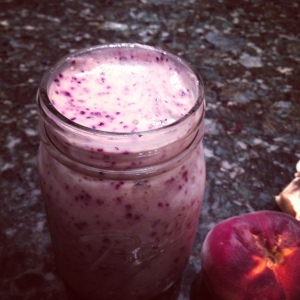 Note: If you prefer to use fresh fruit, just add a few cubes of ice during the blending process.
Note: If you prefer to use fresh fruit, just add a few cubes of ice during the blending process.
1 frozen banana (peeled, obviously)
3/4 c. frozen blueberries
3/4 c. milk (I prefer raw, but whatever you have on hand)
1/2 c. plain yogurt (again, I use raw from a local vendor, but Greek yogurt is comparable here)
1/2 Tbsp. honey
1/4 tsp. salt
Put everything in your blender or food processor, pulse a few times, then blend until smooth and creamy. I make this the night before so it’s ready to go in the morning.
 The title seemed appropriate given that this has been stuck in my head and sea bass was on the King menu.
The title seemed appropriate given that this has been stuck in my head and sea bass was on the King menu.